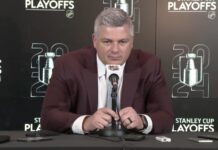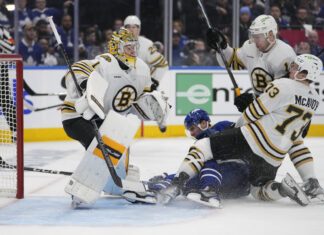It has been another whirlwind offseason for the Toronto Maple Leafs, with too much activity to fit into one article.
With that in mind, I am separating my offseason analysis series into three sections: The Draft, The Phil Kessel Trade, and Free Agency, which will be last as it is still ongoing.
The Phil Kessel Trade
It is entirely possible the only NHLer the Maple Leafs may receive in return for one of the game’s truly elite scorers is Nick Spaling. Now, the odds are against that happening, but that is the risk you run when you just trade for a collection of prospects and picks.
Prior to the draft, we looked at other star wingers traded and the returns they netted. If you add in the Phil Kessel return to this group of trades, it is the only move that does not have the team trading away the star winger receiving at least one good young player already in the NHL in exchange.
The official Phil Kessel trade, in its entirety, is as follows:
To Pittsburgh: Phil Kessel, Tim Erixon, Tyler Biggs, Pittsburgh’s 2016 2nd (from the deadline trade of Daniel Winnik)
To Toronto: Nick Spaling, Kasperi Kapanen, Scott Harrington, Conditional 2016 1st, New Jersey’s 2016 3rd
There are a lot of complex layers to this Kessel trade, though, and it is not fair to look at in a vacuum. Below, I’ll break down everything that needs to be considered, piece by piece. As the old adage goes: the team that receives the best player in a trade, wins the trade. But this deal cannot be judged as easily when there are so many moving parts—it is simply too complex. Let’s break down the important components in this multilayered blockbuster.
The Players
Toronto: Kasperi Kapanen, Scott Harrington, Nick Spaling
Pittsburgh: Phil Kessel, Tim Erixon, Tyler Biggs
Trading an elite scoring winger for a stay at home defensive prospect, a third-line forward (salary dump), a good winger prospect, and a swap of picks, isn’t a great return at face value—no matter how you slice it. The draft picks will be discussed below in greater detail, but the odds of either Scott Harrington or Kasperi Kapanen being anywhere near as good as Kessel—let alone better—are slim to none.
Kessel made the NHL right after being drafted and quickly ascended into becoming one of the most dynamic young snipers in the game. Nothing against Scott Harrington, but at age 22 he was struggling to get ice time and appearances on a Pittsburgh team that was playing Daniel Winnik on defense at the end of the year. Management will be familiar with him due to his time in London, and while he was a good junior player who represented Team Canada at the World Junior Championships, his highest points per game in the OHL was a .52 season. Typically, players who don’t score in junior struggle to have their games translate to the NHL.
By comparison, Tim Erixon is two years older, two inches bigger, has reasonable underlying numbers and has 83 more games played in the NHL. The last time Erixon was in the AHL for an extended period of time, he put up almost a point-per-game, with 38 points in 40 games. In 124 AHL games, Harrington has 36 career points.
Nick Spaling is a cap dump for Pittsburgh, but is not a bad player by any means. He’s only 26 and has proven he can chip in 25-30 points. He’s had a negative Corsi REL every season he’s been in the league, but his versatility and trade value down the road should provide the Leafs some value.
The real gem of the deal for Toronto, though, is Kasperi Kapanen. Kyle Dubas made sure to mention they would not have done the deal without Kapanen, but in fairness, they didn’t receive anything else even remotely worthy of a 28 year old Phil Kessel. Kapanen was one of the youngest players of his draft class and was mere months away from being eligible for the 2015 class instead. He is a good piece to receive in return, and considering how he almost made the Penguins out of camp last year, as well as his strong finish in the AHL, he might not be as far away as people think. A cost controlled top six winger who is under the team’s possession for seven years is a strong asset.
The bigger issue for the Leafs is they didn’t address any sort area of need, as they didn’t acquire a good young defenseman or center (in Pittsburgh’s particular case, Derrick Pouliot and Olli Maatta). As Gus Katsaros noted in an earlier piece on MLHS, the Leafs cornered themselves in on this deal. They clearly wanted Kessel gone, and were bargaining from a position of weakness. Pittsburgh called the shots and got their way.
Kessel going to Pittsburgh and regaining his 30+ goal form will be hard for the Leafs to match in return value wise, particularly in the short term.
The Picks
Toronto: Lottery protected 1st (2016), 3rd round pick (2016)
Pittsburgh: 2nd round pick (2016)
Receiving a 1st and 3rd for a 2nd is an obvious win, but there is a caveat to the deal. The Penguins were able to negotiate lottery protection on their 1st round pick should they fail to make the playoffs — not only this upcoming season, but should it happen again for the 2017 season as well (in which case the pick would become a 2nd).
Now, to some the idea of the Penguins missing the playoffs is so farfetched it’s hardly worth considering, but that seems unreasonably certain, even with the Kessel trade. There are a few things to think about here:
- Legitimately good teams with Cup aspirations are missing the playoffs altogether now, as league parity is at an all-time high and the cap has worked as designed from that perspective. The LA Kings and Boston Bruins are two easy examples from last season, as well as San Jose. Pittsburgh is in a division with the improving Islanders, Capitals and Blue Jackets, the Rangers are still good, and even Philadelphia is starting to make smart moves. This isn’t a “gimme.” Pittsburgh had to beat Buffalo in their last game of the season to make the playoffs last year. The margin for error is that slim; a few injuries to any team has major consequences.
I - The Penguins current top six on D goes Kris Letang, Olli Maata, Ian Cole, Rob Scuderi, Derrick Pouliot, and Ben Lovejoy. It’s a poor defense, and that’s without considering Letang’s history of injuries.
I - They have eight forwards signed, and under $5M in cap space.
I - Playoff teams have acquired star players only to take a step back in recent years. Last season it was Dallas after they acquired Spezza—they were the talk of the summer before bottoming out and missing the post season. The year before was Bobby Ryan’s first in Ottawa after the “pesky Sens” made the playoffs and acquired some scoring (Clarke MacArthur included); they ended up taking a step back in the standings. The year before that, Carolina traded for Jordan Staal and Alex Semin, were expected to do big things, and didn’t (in fairness, they missed the playoffs the year before, too). The larger point is: every summer a team makes a big trade for a star and is seemingly destined for great things on paper only to fail miserably once the games get played. That doesn’t mean Pittsburgh is going to follow suit, but everything stated above, along with this point, gives reason for pause. Would I bet on Pittsburgh making the playoffs? Yes. Would I say it’s a certainty? No.
A 2nd and 3rd round pick from Pittsburgh is still a win, of course, but those are picks the Leafs are able to gain from signing players to one year deals and peddling them at the deadline without a sweat.
The Retained Salary
Part of the Kessel trade required the Leafs to retain $1.2M in salary. There are a number of ways to look at this. With the $71.4M cap ceiling, it accounts for 1.68% of the cap. It is reasonable to expect the cap ceiling to grow in the coming years, so, relatively speaking, it looks like a drop in the bucket in the big picture.
In 2013-14, the average salary of an NHL player was $2.58M, and that has grown to roughly $2.8M since. As the overall cap increases, so too will the average salary. Any way you slice it, though, that money is a significant chunk out of someone’s paycheque somewhere down the line and will be on the books for the next seven seasons. The team has signed a collection of players around this salary in the last two seasons:
- $1.5M PA Parenteau
- $1.5M Mike Santorelli
- $1.2M Matt Hunwick
- $1.2M Daniel Winnik
- $1.1M Mark Arcobello
- $1.1M David Booth
It’s not an insignificant amount of money; as the team gets better, every penny needs to be squeezed under the cap, which is what every good team has to deal with each summer.
There is a second component to retaining Kessel’s salary that is potentially more harmful than the dead money: losing one of three salary retainers for the next seven seasons.
It is no secret Toronto is trying to move players and is also willing to take on contracts in order to do so. Losing one third of their retainers could potentially limit them in their ability to make these moves. For example: if they were to trade Dion Phaneuf and retain some money on his deal — based on the Kessel deal, along with the slow summer, it is fair to say that is likely — then the Leafs will be using two of their retainers until 2021. (People always seem to ask about this: you cannot retain money for a select number years; you have to retain for every year in the deal). Now what? The richest team in the league is going to have one retainer left for the foreseeable future?
The Leafs used two retainers last season: the first on Carl Gunnarsson in the Roman Polak trade, the second on Daniel Winnik to trade him to Pittsburgh.
These seem like little details now, but these will start to become big things if the Leafs ever get to where they want to go.
The Cap Space
On the opposite side of the retained salary consideration is the overall cap space the Leafs have freed up. Kessel accounted for $8M per year against the cap; now they have the $1.2M being eaten, Spaling’s one year, $2.2M cap hit, and Kapanen along with Harrington on ELCs.
That $4.6M opened up is slightly over the combined salary of Shawn Matthias and Daniel Winnik. Neither player is anywhere near Kessel’s stature, but next year the number will get even bigger once Spaling comes off the books.
As noted above, the Leafs will likely have to receive salary back in return to trade some of their other contracts. They will also look to take on a contract in order to receive a prime prospect or draft pick — all part of the advantage of being a big money team.
Further, the prime players they received — Kapanen and Harrington — are cost controlled for years to come.
There’s value in cap space, and it is being overlooked by and large. This is a long game, and how the Leafs use this space, including potentially trading Spaling at some point for more draft picks, is the real judge of this component.
The Phil Factor
If there is one thing that has become clear over the last few weeks, it is that Brendan Shanahan did not want Phil Kessel.
There appears to be a widespread belief in Toronto that Kessel’s attitude and work ethic dragged the team down. He was the best and highest paid player on the team, and thus was the poster boy for failure in Toronto. Never mind that he never played with a legitimate top line center and that JVR was awful defensively; Phil was the guy to blame.
Make no mistake, Kessel was run out of town by the media. All year he was front and center in the news in Toronto as the team’s season spiralled out of control.
There are two realities here:
The first is that the team is trying to wipe the slate clean; what better way to do that than trading the face of a failing team for over half a decade? At the conclusion of the season, Shanahan discussed how the fans in Toronto could stomach a rebuild, but that they wanted to see the team compete and work hard. That simply isn’t the strength of Kessel’s game, and it’s never going to be.
The second truth is that this is a buyers’ market. Patrick Sharp is a good veteran player and a well respected champion across the League. Yes, Chicago is in cap hell, but they just traded him for a 29 year old grinder and a defenseman who has struggled to play defense for a few years now. And they had to throw in a prospect to boot. With that in mind, how could the Leafs possibly trade Joffrey Lupul or Tyler Bozak? Dion Phaneuf is a different story, but Mike Babcock genuinely seems to like him.
So, what other option was there, really? The Leafs aren’t packaging prospects or picks to trade Lupul or Bozak, JVR is young enough to be part of the new core, and Kessel was marketable enough to return value. There was zero chance the team was going to return with the exact same core intact.
That left Kessel.
Shanahan referenced this leading up to the draft, noting:
“He’s probably garnered the most interest. He’s probably the player that has gotten the most phone calls.”
The Leafs traded their best player because he nets them the best return, opens up cap space for further moves, and allows them to turn the page on the old era.
Sometimes, when the best player on a team is traded, the real value is not in the return. It is in clearing the deck and allowing for a new identity to take shape.
Opposite Timelines
When the Leafs acquired Kessel, Leafs fans could not have dreamed of a worse fate the following season. The team was awful, Boston was good, for the first time in forever Toronto was slated to have an elite draft pick—and it was the Bruins to use. To make matters worse, Boston had the Leafs pick the following season, as well. That made watching games frustrating, and it made fans feel hopeless at times.
The dynamics of this trade are a little different. Short of Kessel ripping the league apart in a blaze of glory while on the way to the Cup, fans generally couldn’t care less about what is happening in Pittsburgh, and won’t be devastated if the Leafs suck again; most fans will want another high pick and are happy to be done with Kessel.
The optics of this trade will only really turn sour in Toronto if Kessel begins throwing up 30+ goal seasons year after year while Harrington and Kapanen don’t pan out and the draft picks are weak.
The odds are that Kessel will be good in Pittsburgh for at least a few seasons, but if Kapanen becomes a productive NHLer and is a positive contributor toward turning this team around in two or three years, the trade benefits everyone.
The timelines of these two teams are drastically different. Jim Rutherford is in a knife fight with the Pittsburgh media and is trying to win right now. Toronto is preaching patience and trying to win down the road. If Kessel is good in Pittsburgh the next few years and overpaid by the time Toronto is (hopefully) good, the Leafs will have walked away with some value here (although you could argue they could have traded him for more if he bounces back next year).
The juxtaposition of the arc of these two teams is why the Leafs aren’t getting completely clobbered in this trade. Most fans are on board with a full on rebuild at this point, and if the team is bad again next year, most people will shrug and say “it is part of the process.” Whether that is right or wrong, at least for the start of next season, management seems to be getting a pass for now. That will help them in keeping positive momentum, and is in stark contrast to the walls tumbling down on Brian Burke due to the Seguin-Kessel debacle.
Here are two charts to demonstrate the player and team trajectory curves to be expected. In this scenario, the trade could actually be a win-win situation.
Conclusion
On the surface, this is a tough deal to stomach for Leafs fans. People can say what they want about being happy the team rid themselves of Kessel’s “soft,” or “lazy,” play, but he was an elite scorer with a poor supporting cast. Kapanen is a nice piece coming back, but betting on him to produce anywhere near Kessel’s max would be wishful thinking at this point.
Ultimately, the trade will come down to what Kessel does. Is he going to be the next Dany Heatley, or is he going to be next Alex Kovalev that produces well into his thirties, despite all the knocks on his work ethic and commitment?
The Leafs sold Kessel at the ultimate low. They stood idly by as he got crushed by the media all year, and watched him suffer through his worst shooting percentage season in Toronto, along with his worse PDO year ever. If he returns to form and dominates, it will be another classic case of the Leafs letting fans and media run a star out of town on a knee jerk reaction after a poor season.
A productive Kessel over the course of his deal, part of which the Leafs will be paying for, is a nightmare scenario for Toronto. The return is simply not good enough to justify that at this time, as there is no legitimate NHL value to be gleaned at this point for Toronto other than Nick Spaling.
Maybe Kapanen, Harrington, and the collection of picks pan out for the Leafs, but hitting on a 17 and landing on 21 doesn’t mean you made a smart gamble.

































